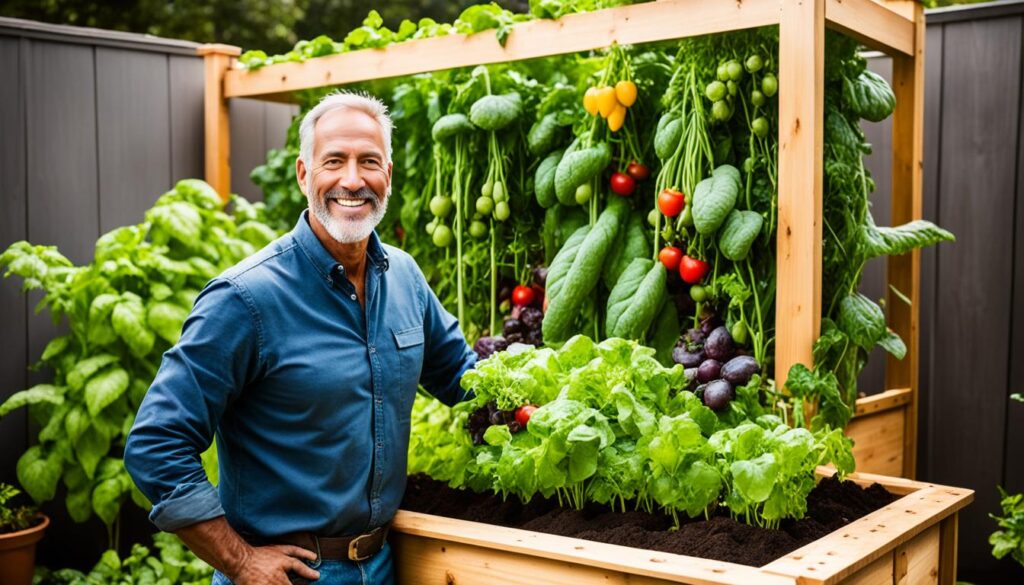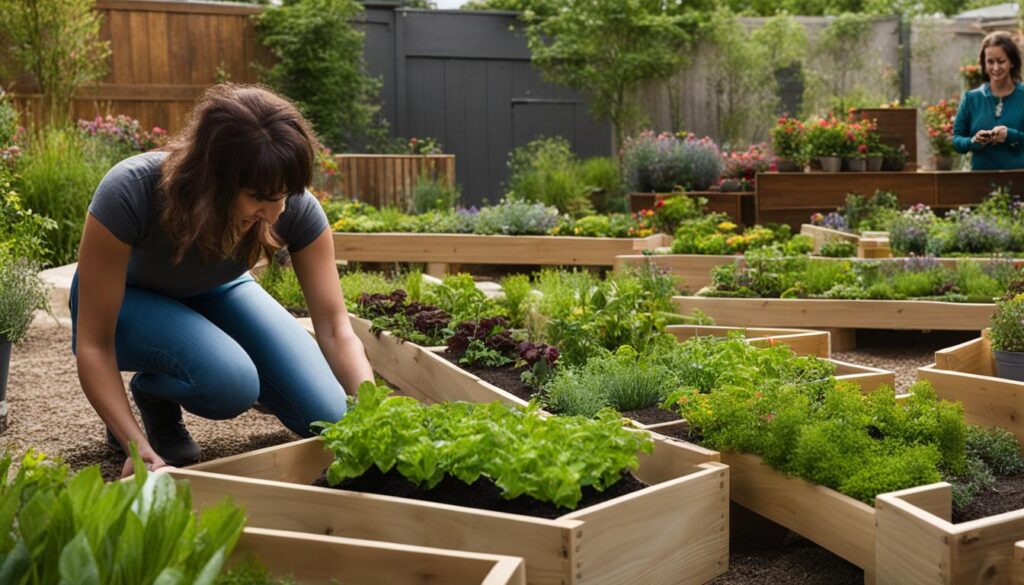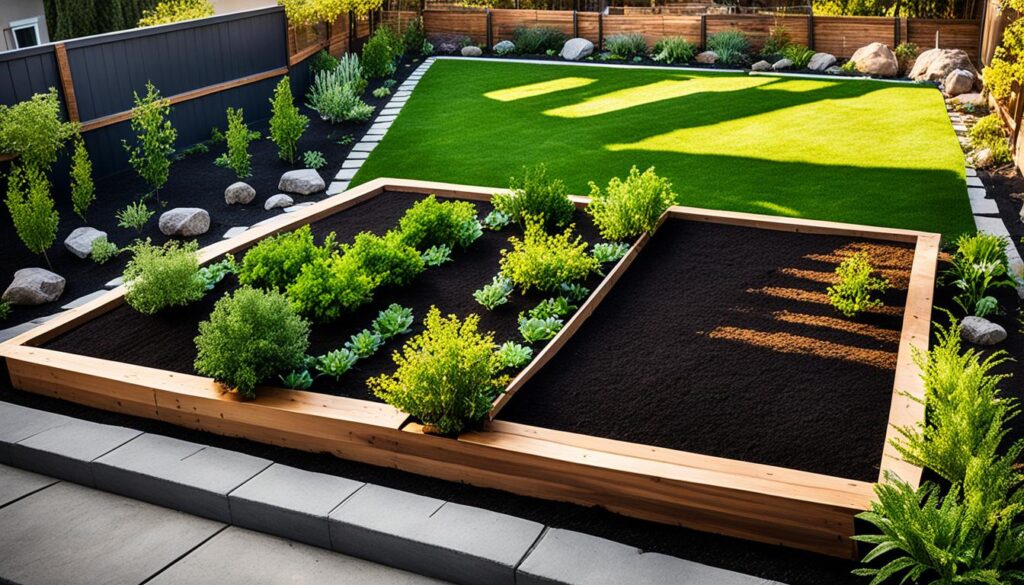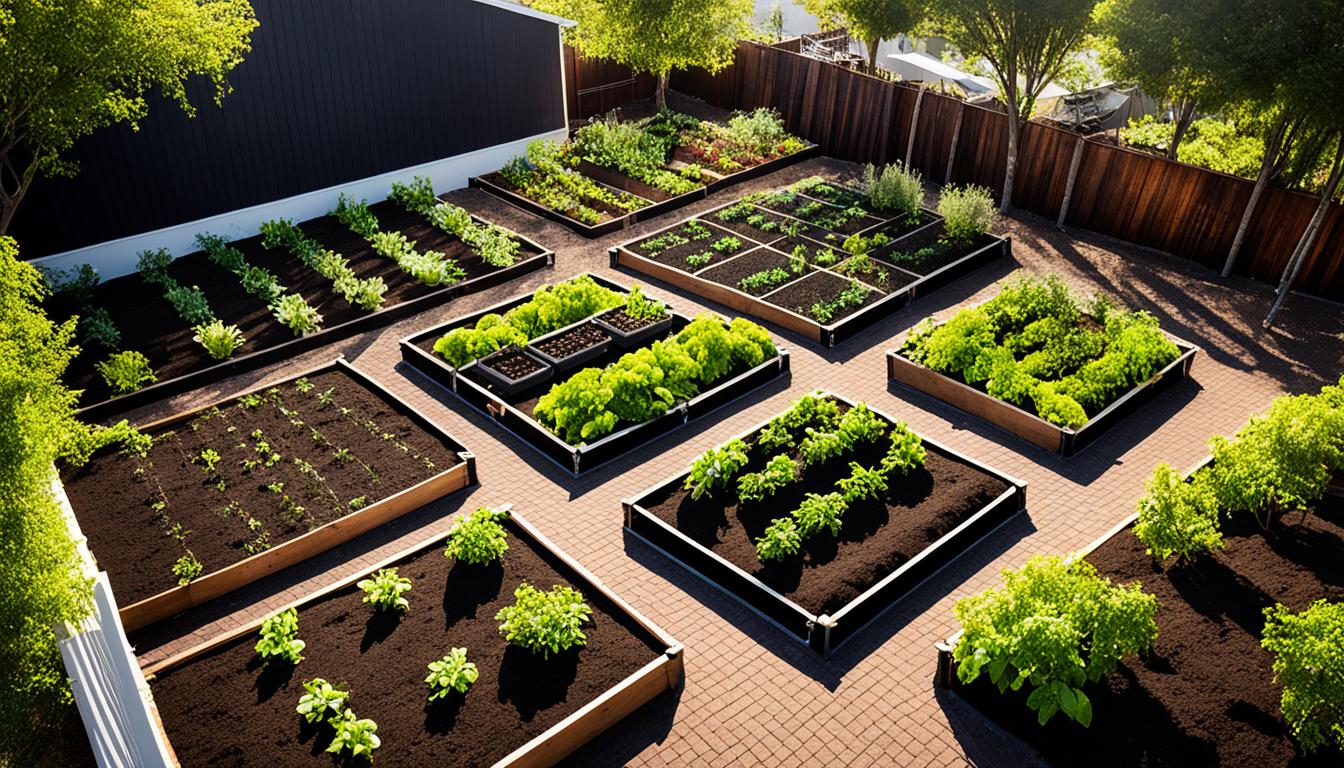Gardening is a wonderful way to connect with nature and enjoy the fruits of your labor. If you’re looking to take your gardening to new heights, consider mastering the art of raised bed gardening and elevated growing techniques. Raised bed gardening offers a practical and efficient way to grow a variety of plants, from fruits and vegetables to herbs and flowers. By using elevated raised bed techniques, you can create a thriving garden that is not only aesthetically pleasing but also easier to maintain.
One of the key benefits of raised bed gardening is the control it gives you over the growing environment. The raised beds provide a barrier between the soil and surrounding weeds, reducing the need for regular weeding. This technique also helps to deter ground-dwelling pests and protects against soil-borne diseases. With elevated raised bed gardening, you can say goodbye to backaches and knee strains, as the raised beds provide a comfortable working height, eliminating the need to bend over or kneel while working in the garden.
Key Takeaways:
- Mastering the art of raised bed gardening allows for efficient and practical plant cultivation.
- Elevated raised bed techniques provide better control over the growing environment.
- Reduced weeding and pest control are some of the benefits of raised bed gardening.
- With elevated raised beds, gardening becomes more comfortable and accessible.
- By using raised bed techniques, you can create a thriving and beautiful garden.
Introduction to Elevated Raised Bed Gardening
Elevated raised bed gardening is a hybrid gardening technique that combines the advantages of container gardening and traditional raised bed gardening. With this method, the soil is completely contained, creating a substantial growing area at a comfortable working height. This eliminates the need to bend over or kneel while planting, maintaining, and harvesting the plants. It offers a convenient and efficient way to grow a wide variety of plants.
Elevated raised bed gardening provides several benefits over conventional gardening methods. This approach allows for better control over soil quality, moisture, and drainage, making it suitable for various soil types. The contained soil also acts as a barrier against weeds, reducing the need for frequent weeding. In addition, elevated raised beds help protect plant roots from ground-dwelling pests and minimize the risk of soil-borne diseases.
Growing Techniques
When it comes to elevated raised bed gardening, there are several growing techniques that you can employ. One popular technique is square foot gardening, where the growing area is divided into smaller sections to maximize space utilization. Another technique is intercropping, where different plants are grown together to maximize yields and deter pests.
“Elevated raised bed gardening offers a practical, space-efficient, and streamlined approach to growing a wide range of plants.”
Container gardening techniques can also be incorporated into elevated raised bed gardening. You can use various containers, such as pots or hanging baskets, within your raised bed to grow plants that require different soil conditions or have specific watering needs.
Choosing the Right Plants
With elevated raised bed gardening, you have the flexibility to grow a wide variety of plants. You can grow vegetables, herbs, flowers, and even small fruit trees or shrubs. Consider the specific needs of each plant, such as sunlight requirements and spacing recommendations. This will help you make informed decisions when selecting plants for your elevated raised bed garden.
Container Gardening in Elevated Beds
Container gardening is especially well-suited for elevated raised beds. The contained soil provides ample space for plants to develop strong root systems, leading to healthier and more productive plants. Additionally, the elevated height of the beds makes it easier to water, fertilize, and care for the plants without straining your back or knees.
| Plant Type | Recommended Varieties |
|---|---|
| Vegetables |
|
| Herbs |
|
| Flowers |
|
Elevated raised bed gardening provides a versatile and accessible way to enjoy the benefits of gardening, regardless of available space or physical limitations. Whether you are a beginner or an experienced gardener, elevated raised bed gardening techniques can help you create a thriving garden.
Benefits of Elevated Raised Bed Gardening
Gardening in elevated raised beds offers numerous benefits. Let me walk you through some of the advantages:
Weed Control
“Gardening in raised beds eliminates the need for regular weeding by providing a barrier between the soil and surrounding weeds.”
With elevated raised beds, you can say goodbye to hours spent pulling pesky weeds. The raised beds create a physical separation between the soil and the surrounding weeds, minimizing the growth of unwanted plants. This means less time spent on weed control and more time enjoying your garden.
Pest Control
“Raised beds reduce the risk of ground-dwelling pests damaging plant roots and protect against soil-borne fungal diseases.”
By elevating your garden, you create a physical barrier that deters pests like rabbits and groundhogs from snacking on your precious plants. Furthermore, the controlled environment of raised beds helps protect your plants from soil-borne fungal diseases that can result in poor growth and yield. This means healthier plants and a more successful harvest.
Soil Health
“Elevated gardening techniques provide better control over soil moisture and drainage, making it suitable for various soil types.”
One of the significant advantages of raised bed gardening is the ability to have optimal control over soil conditions. You can tailor the soil composition to suit your plants’ needs, ensuring excellent drainage and moisture retention. This is particularly beneficial for individuals gardening in areas with heavy clay or sandy soil, where soil quality can be a challenge.
Harvesting Convenience
“Raised beds provide easy access for harvesting, making the process more convenient and enjoyable.”
Gardening in elevated raised beds offers the convenience of easy access. The elevated height eliminates the need for bending or kneeling, reducing strain on your back and knees. This makes it easier to tend to your plants, inspect for pests, and, of course, harvest your fresh produce. Say goodbye to sore muscles and hello to effortless gardening!
Now that you’ve learned about the benefits of gardening in elevated raised beds, you can see why it’s becoming a popular choice for both novice and experienced gardeners alike. Let’s explore the selection of the right raised planter box in the next section.

Continue reading to discover how to select the perfect raised planter box for your elevated garden.
Selecting the Right Raised Planter Box
When it comes to elevated raised bed gardening, choosing the right raised planter box is crucial. Several factors need to be considered to ensure the success of your gardening venture. Let’s delve into the key elements you should keep in mind when selecting a planter box for your elevated raised bed:
Material
The material of the planter box plays a significant role in its durability and weather resistance. Opt for raised planter boxes made from materials like cedar, which are known for their longevity and ability to withstand outdoor conditions. Cedar is naturally resistant to rot, decay, and insect damage, making it an ideal choice for your elevated garden.
Size
Consider the size of the planter box when making your choice. The planter box should be deep enough to accommodate root crops like carrots and radishes. Additionally, make sure the planter provides ample space for larger plants, allowing them to spread their roots and grow freely.
Maintenance
Minimizing maintenance tasks can make your gardening experience more enjoyable. Look for a planter box that requires minimal upkeep, such as one that doesn’t need annual painting or staining. A low-maintenance planter box will save you time and effort in the long run.

“Choosing a raised planter box that meets your specific needs and preferences will set the foundation for a successful elevated raised bed garden.”
By considering these factors during the selection process, you can ensure that your raised planter box is not only aesthetically pleasing but also practical and conducive to healthy plant growth. Remember, the right choice of material, size, and maintenance requirements can make a significant difference in your gardening experience.
Placing Your Elevated Garden Planter
The placement of your elevated garden planter is crucial for the success of your plants. Choosing the right location ensures that your plants receive the necessary sunlight, water, and accessibility for optimal growth.
1. Sunlight
When selecting a spot for your raised bed, make sure it receives at least six hours of sunlight daily. Sun-loving plants require ample sunlight to thrive and produce a abundant harvest. Position your elevated planter in an area that offers full sun exposure, allowing your plants to soak up the rays and photosynthesize efficiently.
2. Water Source
Proximity to a water source is essential for the health and hydration of your plants. Ensure that your raised bed is conveniently located near a spigot or rain barrel, providing easy access to water. This allows you to quickly and efficiently water your plants, keeping them hydrated during hot summer days or dry spells. Adequate moisture is essential for the growth and development of your plants, promoting healthy root systems and vibrant foliage.
3. Accessibility
The accessibility of your elevated garden planter is crucial for convenient maintenance and harvesting. Choose a location that is easily accessible, allowing you to tend to your plants without straining or bending over. This makes tasks such as planting, pruning, and harvesting more comfortable and enjoyable. Consider the height and placement of your planter to ensure comfortable access for all your gardening activities.
| Placement Requirements | Sunlight | Water Source | Accessibility |
|---|---|---|---|
| Recommended | At least 6 hours of sunlight daily | Close to a water source (spigot or rain barrel) | Easily accessible for maintenance and harvesting |
| Avoid | Shady areas with limited sunlight | Far from a water source, requiring long hoses | Difficult to reach or strained posture for gardening activities |
By carefully considering the placement of your elevated garden planter, you can provide your plants with the ideal conditions for growth and maximize your gardening experience.

Filling Your Raised Planter Box
When it comes to filling your raised planter box, using the right soil mix is crucial for the success of your plants. Native soil is not recommended because it may not provide the proper drainage and nutrient levels necessary for optimal growth. Instead, opt for a soil mix specifically designed for raised bed gardening.
A great soil mix for raised beds is a combination of potting soil and compost. Aim for a ratio of approximately 2/3 potting soil to 1/3 compost. This blend creates a well-balanced mix that retains moisture while allowing excess water to drain properly. It also provides essential nutrients for your plants to thrive.
If you’re looking to promote even more robust plant growth, consider adding organic granular fertilizer to the soil mix. This will help ensure your plants receive the necessary nutrients throughout the growing season.
Pro tip: For specific plants like cacti and succulents that prefer well-draining soil, you can substitute compost with coarse builder’s sand in your soil mix.
The goal is to create a loose, well-draining soil mix that allows roots to access water and nutrients while also preventing waterlogging, which can lead to root rot. This balanced soil mix will provide a healthy environment for your plants to thrive and produce an abundant harvest.
Now that you know how to fill your raised planter box with the right soil mix, you’re one step closer to creating a flourishing garden.

What to Grow in an Elevated Raised Bed
Elevated raised beds offer a versatile growing space for a wide variety of plants. Whether you’re interested in vegetable gardening, herb gardening, or flower gardening, there are plenty of options to choose from. Here are some plants that thrive in elevated raised beds:
Vegetable Gardening:
- Tomatoes
- Eggplants
- Peppers
- Carrots
Herb Gardening:
- Basil
- Thyme
- Lemongrass
- Rosemary
- Parsley
Flower Gardening:
- Small-statured berry plants
- Beautiful flowers
Additionally, you can add unique elements to your elevated garden by incorporating fairy gardens, miniature plants, dwarf shrubs, and evergreens. These can create a whimsical and enchanting atmosphere in your garden.
Experiment with different combinations of plants to create visual interest and maximize productivity in your elevated raised bed garden. Remember to consider the specific growing requirements of each plant, including sunlight, water, and soil conditions. With a little planning and care, your elevated raised bed garden will thrive with a bountiful harvest of vegetables, aromatic herbs, and vibrant flowers.
Tips for Successful Raised Bed Gardening
To ensure success in your raised bed gardening, follow these tips.
Choose the Right Location
When selecting a location for your raised bed garden, consider the following:
- Ensure the area receives adequate sunlight for your plant’s needs.
- Place the raised bed garden near a water source for convenient watering.
Consider Different Planting Schemes
Experiment with various planting schemes to maximize your garden’s productivity:
- Try traditional rows for organized and easy maintenance.
- Explore broadcast seeding for a more natural and random pattern.
- Consider succession planting to extend the harvest season.
Water at the Roots
Watering the roots of your plants is essential for optimal growth:
- Use a soaker hose or drip irrigation system to deliver water directly to the roots.
- Avoid overhead watering to prevent disease and water waste.
Protect Your Plants
Protecting your plants from extreme weather and pests is crucial:
- Use row covers or garden fabric to shield plants from frost and cold temperatures.
- Implement plant protection methods, such as physical barriers or organic pesticides, to deter pests.
Remember, successful raised bed gardening requires careful consideration of factors such as location, planting schemes, watering, and plant protection. By implementing these tips, you’ll be well on your way to a thriving garden.
Choosing the Correct Materials for Your Raised Bed
Selecting the right materials for your raised bed is crucial to ensure its durability and longevity. While wooden beds are commonly used, they may break down faster and require more maintenance over time. For a convenient and long-lasting option, consider metal raised beds with modular components. These beds are easy to set up and customize according to your space requirements.
Metal beds also offer the advantage of eliminating the risk of chemical leaching from treated wood, making them a safe choice for growing your plants. If you’re looking for high-quality metal raised garden beds, I recommend exploring the options offered by Vego Garden, a reputable supplier in the industry.
When choosing the materials for your raised bed, it’s essential to prioritize durability, low maintenance, and the health of your plants. Investing in a quality metal raised bed with modular components will provide a stable and long-lasting foundation for your gardening endeavors.
Check out the image below to visualize the sturdiness and versatility that metal beds with modular components offer:
Wrapping Bubble Foil and Adding Mulch
One effective way to enhance the performance of your raised beds is by wrapping bubble foil around them during spring or autumn. The bubble foil acts as a protective shield, trapping heat and insulating the soil, which helps promote plant growth. This technique is especially useful if you want to start your plants earlier or extend the harvest season. To wrap the bubble foil around your raised beds, simply cut the foil to the appropriate size and secure it with garden staples or clips.
Another essential step in maintaining your raised beds is adding a layer of mulch at the end of the growing season. Mulching not only protects the soil from harsh winter weather but also conserves moisture, preventing it from evaporating. In addition, mulch acts as a barrier, effectively suppressing weed growth. Applying mulch is a simple process: spread a 2-inch layer around your plants and gently press it down to ensure optimal coverage.
By incorporating the use of bubble foil and mulch in your raised bed gardening routine, you provide your plants with the winter protection they need while conserving water and promoting healthy growth.
| Benefits | Explanation |
|---|---|
| Winter protection | The bubble foil acts as an insulating layer, protecting the soil and plant roots from freezing temperatures. |
| Heat retention | The bubble foil helps trap heat, keeping the soil warm and promoting plant growth even during cooler seasons. |
| Moisture conservation | Mulch conserves moisture in the soil, reducing the need for frequent watering and promoting efficient water usage. |
| Weed suppression | Mulch acts as a barrier, preventing weed growth and minimizing the competition for nutrients and water. |
Conclusion
Raised bed gardening with elevated growing techniques is a game-changer for garden enthusiasts. With the tips and methods discussed in this article, you can become a master of raised bed gardening and enjoy the benefits of a thriving garden. By carefully choosing the right location, materials, and plants, and ensuring the soil is of high quality, your elevated raised bed garden will yield impressive results.
The advantages of raised bed gardening are numerous. Not only does it provide a practical and efficient way to grow different types of plants, but it also offers benefits such as weed control, pest control, and improved soil health. The convenience it provides for maintenance and harvesting is unmatched, making gardening a stress-free and enjoyable activity.
So, why wait? Start your journey into the world of raised bed gardening today. With the right techniques and a little bit of care, your garden will flourish, and you’ll be rewarded with a bountiful harvest. Happy gardening!
FAQ
What is elevated raised bed gardening?
Elevated raised bed gardening is a hybrid gardening technique that combines the advantages of container gardening and traditional raised bed gardening. It involves using raised planters that are elevated off the ground, creating a substantial growing area at a comfortable working height.
What are the benefits of elevated raised bed gardening?
Elevated raised bed gardening offers several benefits, such as eliminating the need for regular weeding, reducing the risk of ground-dwelling pests and soil-borne diseases, deterring rabbits and groundhogs, providing better control over soil moisture and drainage, and offering easy access for harvesting.
How do I select the right raised planter box?
When choosing a raised planter box, consider the material (such as durable and weather-resistant cedar), ensure it is safe for growing food, check the size (deep enough for root crops and spacious enough for larger plants), and opt for one that requires minimal maintenance.
Where should I place my elevated garden planter?
Choose a location that receives at least six hours of sunlight and is close to a water source. Consider the accessibility for maintenance and harvesting. If growing sun-loving plants, place the planter in full sun; for shade-loving plants, find a spot that offers partial shade. Ensure the planter is close to a water source for easy watering.
What should I fill my raised planter box with?
Avoid using native soil and opt for a soil mix suitable for raised bed gardening. A mixture of potting soil and compost works well, with a ratio of approximately 2/3 potting soil to 1/3 compost. Consider adding organic granular fertilizer to promote plant growth.
What can I grow in an elevated raised bed?
Elevated raised beds offer a versatile growing space for a wide variety of plants. Consider planting compact vegetable varieties, herbs, small-statured berry plants, flowers, fairy gardens, miniature plants, dwarf shrubs, and evergreens.
What are some tips for successful raised bed gardening?
Choose the right location with adequate sunlight and access to water, consider different planting schemes, water at the roots, protect plants from extreme weather and pests, and use high-quality materials for your raised bed.
How do I choose the correct materials for my raised bed?
Depending on your preferences, wooden beds are common but require more maintenance, while metal beds with modular components offer convenience and durability. Metal beds also eliminate the risk of chemical leaching from treated wood.
How can I wrap bubble foil and add mulch to my raised beds?
Wrapping bubble foil in spring or autumn helps retain heat and promote plant growth. Adding a layer of mulch at the end of the growing season protects the soil from winter weather and conserves moisture. Apply a 2-inch layer of mulch around your plants and gently press it down for optimal results.

